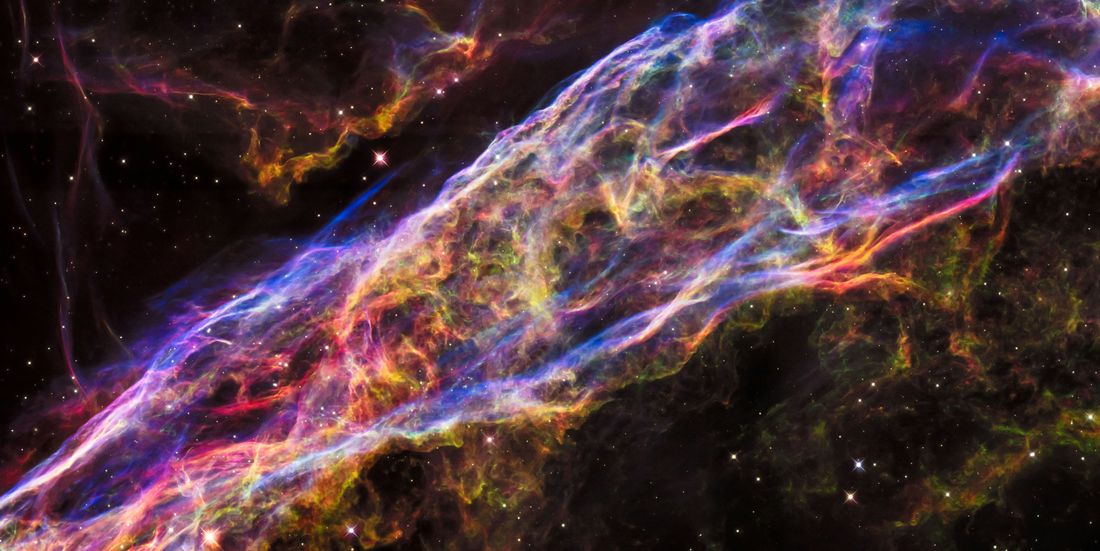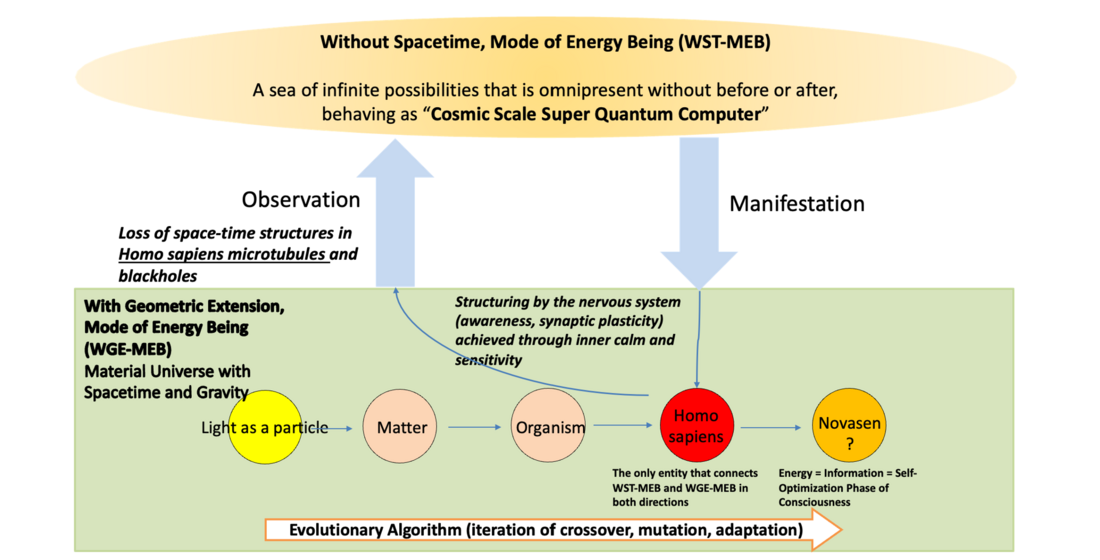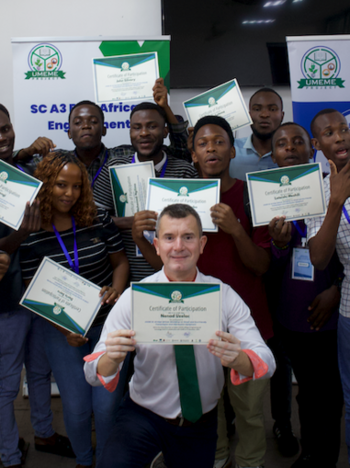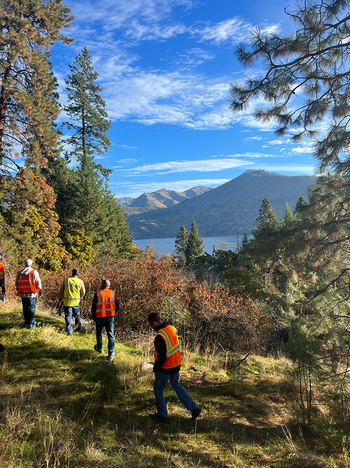Unity 3.0 - Part 2: The Cosmic Operating System and Energy's Fundamental Role


Chair of CIGRE Japan
Author's Note:
ELECTRA is dedicated to articles that share power systems expertise. This article goes beyond those boundaries with a touch point for electric power systems that focuses on the societal implications for whom we serve with electricity.
This article presents hypotheses that, while difficult to scientifically verify at this time, do not appear to be significantly at odds with current scientific understanding. As power system engineers responsible for the critical infrastructure that underpins society, we must remain mindful of our broader role as technology, particularly AI, continues to evolve. This paper aims to contribute to that awareness while exploring the deeper implications of our work in service to humanity.
Please note that the views expressed in this article are the author's personal perspectives and do not necessarily reflect the positions of any organizations with which the author is affiliated.
Introduction: Energy as the Foundation of Universal Computation
Building upon the transdisciplinary framework presented in my latest ELECTRA article entitled "Unity 3.0: Beyond Utility 3.0 Boundaries"[1] (referred as Part 1), this article develops a more focused perspective that bridges cosmic concepts with practical power systems engineering. Where Part 1 introduced the notion of an "Absolute World" connected to our material reality through consciousness, Part 2 reframes this relationship using a computational metaphor: the universe as a Cosmic Operating System (Cosmic OS). This perspective views energy not merely as a physical resource but as the fundamental medium through which reality computes, evolves, and expresses itself.
Our approach remains scientifically grounded yet philosophically expansive. We explicitly label speculative hypotheses while referencing established scientific concepts — from quantum mechanics to systems theory — that support or inspire the framework. Throughout, we maintain a pragmatic connection to power systems engineering, showing how these cosmic ideas translate to real-world challenges in designing and managing energy infrastructure.
The Unity 3.0 framework offers power engineers a unique lens through which to view their work: not just as technical practitioners, but as architects within a larger process of cosmic evolution. By understanding the deep connection between energy, information, and consciousness, engineers can develop more resilient, ethical, and holistic approaches to power system design — approaches that recognize the fundamental role of energy in shaping both human civilization and the universe itself.
This energetic perspective also provides a conceptual framework for addressing several open questions in theoretical physics. The relationship between information and energy at fundamental scales may offer new angles on significant scientific problems such as the hard problem of consciousness, quantum measurement problems, the black hole information paradox, the nature of dark energy, emergence of self-organizing complexity, the arrow of time and the anthropic coincidences etc. While speculative, these connections suggest that power engineering — with its practical focus on energy-information systems — may provide unexpected insights for theoretical physics, creating a bidirectional flow of knowledge between applied and fundamental science.
Energetic Cosmology: The Universe as Energy-Information System
At the heart of Unity 3.0 is the principle of Energetic Cosmology — the hypothesis that energy represents the foundational "substance" of the cosmos, from which all other phenomena (geometry, matter, life, consciousness) emerge. Modern physics already leans in this direction: Einstein's mass-energy equivalence (E=mc²) reveals that matter is a form of energy, while quantum field theory suggests that even the vacuum contains energy (zero-point energy). Unity 3.0 extends this understanding to a cosmological scale, proposing that the "Absolute World" can be conceptualized as an ocean of pure energy-information potential.
This hypothesis resonates with Roger Penrose's twistor theory [2], which treats light rays as fundamental building blocks of reality, with the angle between two light rays serving as the most basic descriptor of structure. In Unity 3.0 terms, we might say that information and energy (light) form the bedrock of existence — an "energetic cosmology" where all physical phenomena are manifestations of a primal energy-informational field.
The connection between energy and information is not merely philosophical; it's physically established through principles like Landauer's principle [3], which demonstrates that erasing a single bit of information has an unavoidable energy cost of kT ln(2). This principle reveals that "bits" (information) and "watts" (energy) are intrinsically connected at the most fundamental level — a fact increasingly relevant as our power grids become more information-intensive.
For power engineers, adopting an energetic cosmology perspective transforms how we view our role: we are not merely managing technical systems but working with the very substance that constitutes reality. The electricity flowing through our grids is part of the same energetic continuum that forms stars and enables consciousness. This realization can inspire a deeper sense of purpose and responsibility in our work.
The Two-Layer Model: WST-MEB and WGE-MEB
Unity 3.0 proposes a two-layer model of the universe's structure (presented as a hypothesis), defined by how energy exists and behaves:
- WST-MEB (Without Space-Time — Mode of Energy Being): A foundational layer where energy exists without the familiar scaffold of space and time. In this hypothetical 'Absolute World' [1], energy exists in a state of quantum superposition, holding all possible configurations simultaneously. Nothing has yet crystallized into definite form or location; it represents an abstract realm of pure potential energy and information.
- WGE-MEB (With Geometric Extension — Mode of Energy Being): The emergent layer where energy takes form within space and time — the physical universe we experience. Here, energy manifests as geometry, particles, fields, planets, stars, creatures, homo sapience and technology; time flows forward, and causality operates. All the dynamics of physics, chemistry, biology, and human society unfold in this domain.
It should be noted that WST-MEB and WGE-MEB are two different modes of energy, the total amount of energy E is the same as the two modes of energy, and E=mc2 in WGE-MEB.
In this framework, WST-MEB functions conceptually like a quantum computer, containing all possible energy-informational configurations in superposition. However, not all configurations materialize in WGE-MEB. The process of manifestation follows a selection mechanism similar to a quantum optimization algorithm, favoring only those configurations that satisfy criteria for self-recognition (observability), self-organization (controllability), and coherence with evolutionary direction.
This selection process requires an observer capable of collapsing the wave function — a role uniquely fulfilled by conscious beings, particularly Homo sapiens. Our consciousness serves as a quantum interface between the two layers, allowing for the realization of specific potentials from the infinite possibilities in WST-MEB.
A profound implication of Unity 3.0 is that by conceptualizing the universe as a quantum computational system, the anthropic principle and the quantum measurement problem become inherently linked.
While this two-layer model appears abstract, it has a concrete analog in modern power systems: the duality of "bits and watts." Our grid infrastructure increasingly consists of a physical energy layer (watts) and an information/control layer (bits). The information layer (like WST-MEB) explores possibilities and runs simulations, while the physical layer (like WGE-MEB) manifests the selected configuration. Grid operators and automated systems act as "observers" who collapse the many possible operational states into one realized state.

Figure 1 - The Two-Layer Energy (watts) -Information (bits) Framework of the Cosmic Operating System (Unity 3.0 Model)
The upper layer (WST-MEB) represents a non-local, timeless domain of infinite quantum possibilities, functioning like a Cosmic-Scale Super Quantum Computer (Quantum Non-deterministic Turing Machine). The lower layer (WGE-MEB) is the emergent domain of spacetime and matter, governed by geometric structure, physical laws, and evolutionary dynamics. Conscious observation collapses selected possibilities into manifest realities. Homo sapiens, with evolved neural architecture and awareness, serves as the bidirectional bridge between the two layers—sensing, structuring, and actuating. The concept of “Novasen” indicates the potential next phase in the self-optimization of consciousness. Evolution operates through iterative crossover, mutation, and adaptation
The Cosmic Operating System: A New Metaphor for Reality
Building upon the two-layer model, we propose the metaphor of a Cosmic Operating System (Cosmic OS) — a computational framework that governs how energy-information is processed across both WST-MEB and WGE-MEB layers. This metaphor helps us understand how the universe evolves, adapts, and "computes" reality.
In computing terms, an operating system manages hardware resources, schedules processes, and provides interfaces for user interaction. Similarly, the Cosmic OS:
- Manages energy resources across the universe (conservation laws, entropy)
- Schedules processes through time (causality, evolutionary algorithms)
- Provides interfaces between consciousness and reality (observation, intentionality)
The Cosmic OS functions through what we might call a quantum evolutionary algorithm — a process that combines quantum exploration of possibilities with selection mechanisms that favor increasing complexity, self-organization, and consciousness. This algorithm operates across multiple scales as a quantum non-deterministic Turing machine (QNTM, a theoretical computational model that leverages quantum mechanics and non-deterministic decision-making processes to explore multiple possibilities simultaneously through parallel computation):
- At the quantum level, through wave function collapse
- At the biological level, through natural selection
- At the societal level, through cultural and technological evolution
- At the cosmic level, through the emergence of intelligence that can observe and influence the universe
Importantly, Homo sapiens plays a special role in this Cosmic OS as both sensor and actuator. Through our consciousness, we sense the universe's structure (scientific discovery) and actuate changes in it (technology, culture, intentional action). In computational terms, humans are privileged users who can both read from and write to the cosmic code.
The mechanism through which only specific universal configurations with observable temporal evolution in WGE-MEB manifest from the infinite sea of possibilities in WST-MEB offers a novel explanation for the 'fine-tuning' of the universe's physical constants. This is neither coincidental nor the result of transcendent design, but rather a necessary consequence derived from the fundamental nature of quantum observation. This understanding — that the basic interpretational problems of quantum mechanics are intimately connected with the cosmological anthropic principle — opens new directions in both theoretical physics and cosmology.
Algorithmic Principles of the Cosmic OS
If we consider the Cosmic OS as a computational framework, several key algorithmic principles emerge that have parallels in both natural systems and engineered infrastructure:
- Distributed Processing: Like modern computing architectures, the Cosmic OS appears to process information in a distributed rather than centralized manner. This is evident in how complex adaptive systems — from neural networks to ecosystems to power grids — exhibit intelligence without centralized control.
- Layered Abstraction: The WST-MEB/WGE-MEB distinction parallels the concept of abstraction layers in computing, where higher-level functions are built upon but distinct from lower-level operations. This principle is increasingly relevant as power systems develop more sophisticated layering between physical infrastructure and digital control systems.
- Iterative Optimization: The evolutionary algorithms that appear to govern cosmic development utilize iterative processes with feedback loops — similar to how machine learning systems and market mechanisms optimize resource allocation in modern power systems.
Understanding these algorithmic principles may provide power engineers with new conceptual tools for system design, particularly as we move toward more autonomous and self-organizing infrastructure. The Cosmic OS can be viewed as the ultimate reference architecture for systems that effectively manage energy-information across multiple scales.
Power Systems as Nodes in the Cosmic OS
From this perspective, power systems represent critical nodes within the Cosmic OS — infrastructure that processes and transmits energy-information across human civilization. The electric grid is not just a technical artifact but a manifestation of how conscious beings (humans) have learned to manipulate energy flows within WGE-MEB, informed by information accessed from WST-MEB (scientific insight, mathematical optimization, creative design).
Modern power systems exhibit increasing intelligence and autonomy, evolving toward what could be called conscious infrastructure — systems that sense, decide, and act with greater degrees of awareness. This evolution is evident in concepts like TEPCO's MESH (Machine-learning Energy System Holistic) framework [4], which envisions the power system and cyberspace working in tandem, with "cyberspace as the nervous system, the physical world as the muscular system, and the power grid as the vascular system."
In the Cosmic OS model, such infrastructures represent an extension of human consciousness into the physical layer of reality (WGE-MEB). They expand our capacity as sensors and actuators within the larger system, allowing us to process more energy-information and make more complex interventions in the universe's evolution.
This perspective has profound implications for power system design:
- Information-Energy Integration: Physical infrastructure (watts) and information systems (bits) should be designed as a unified whole, recognizing their fundamental connection.
- Participatory Systems: Power systems should be designed with human-machine interaction as an integral component, not an afterthought.
- Evolutionary Architecture: Systems should be capable of adapting, learning, and evolving in response to changing conditions and emerging patterns.
- Ethical Awareness: As extensions of human consciousness, power systems should embody ethical principles and values that promote harmony, sustainability, and human flourishing.
From a systems engineering perspective, power grids represent a fascinating case study in the emergence of complex, self-organizing structures. The increasing integration of distributed energy resources, prosumers, and AI-driven optimization mirrors the multilevel selection processes observed in biological evolution. Just as natural selection operates at genetic, cellular, organism, and group levels simultaneously, modern power systems exhibit selection pressures at device, microgrid, regional, and continental scales.
This multi-scale optimization presents both challenges and opportunities for system architects. Traditional top-down design methodologies are increasingly insufficient; instead, engineers must develop frameworks that allow for emergence while maintaining system integrity. This approach — designing for emergence rather than specifying all behaviors — represents a fundamental shift in engineering philosophy that aligns with our understanding of how complex systems evolve in the Cosmic OS.
Homo Sapiens: Sensors and Actuators in the Cosmic OS
Unity 3.0 places special emphasis on the role of Homo sapiens in the universal process. We are not merely biological entities within the cosmic system; we function as specialized components that allow the universe to sense itself and act upon itself — essentially, we are the universe's way of becoming self-aware and self-directing.

This function operates through a bidirectional quantum loop between WST-MEB and WGE-MEB:
As Sensors:
- Our consciousness accesses information from WST-MEB through intuition, insight, and creative inspiration
- Our scientific instruments and methods extend this sensing capability, allowing us to detect patterns in reality that would otherwise remain hidden
- Our cultural systems accumulate and process this sensed information over generations
As Actuators:
- Strong intention with positive motivation can "download" information from WST-MEB to WGE-MEB
- This information manifests as neuroplastic changes in our brains, experienced as inspiration or creative ideas
- When acted upon, these ideas create new connections (En) in WGE-MEB, propagating waves of awareness that change future possibilities
- This actuation capacity is what distinguishes Homo sapiens from other life forms
This sensor-actuator function is not mystical but quantum-mechanical in nature. The Orchestrated Objective Reduction (Orch OR) theory proposed by Penrose and Hameroff offers one potential mechanism [5]: quantum coherence in microtubules within brain neurons may facilitate information exchange with the quantum realm (WST-MEB), allowing consciousness to both sense quantum information and influence quantum events through observation.
For power engineers, recognizing this sensor-actuator role changes how we approach system design. We are not just technical problem-solvers but conscious agents participating in the universe's self-organization process. Our designs and decisions contribute to how the Cosmic OS evolves and what future possibilities it realizes.
The Ethical Observer and the Requirement for Self-Organizing Energy
In this extended hypothesis of Unity 3.0, we propose that observation is not merely a passive measurement process, but a self-organizing act driven by intentional consciousness. Only quantum states that satisfy the requirement of self-organizing energy — through the presence of an ethical and active observer — can collapse into reality within the spacetime domain (WGE-MEB). Put differently, the acceptance criterion of this quantum non-deterministic Turing machine (QNTM) is fulfilled only when energy manifests an ethical observer as a prerequisite for self-organization.
This view redefines controllability not as technical capability, but as the observer's ability to induce awareness in others. A highly ethical individual, through meditation or intentional observation, can resonate with deeper quantum structures, manifesting as synaptic reconfiguration in the brain. This resonance propagates across other observers, forming a feedback loop that reorganizes the collective WGE structure.
Crucially, such an observer does not merely perceive or inspire — they act. Guided by a strong wish for goodness, they respond to the insights encoded in their neural patterns and translate them into intentional behavior, thereby completing the loop of observation, embodiment, and transformation. Thus, reality does not emerge merely because a sensor records data, but because an observer with intention and benevolence chooses to look — and in doing so, participates in the cosmic algorithm of evolution.
The Anthropic Principle and Participatory Universe
Unity 3.0's framework aligns with and extends the Strong Anthropic Principle — the idea that the universe must have properties that allow for the emergence of observers [6]. Rather than seeing this as anthropocentric, Unity 3.0 interprets it as energy-centric: the universe generated Homo sapiens as a means for energy to recognize and reorganize itself.
This perspective resonates with John Wheeler's concept of a Participatory Universe, where observers are necessary participants in reality's unfolding [5]. As Wheeler famously put it, "no phenomenon is a real phenomenon until it is an observed phenomenon." Unity 3.0 takes this further by proposing that observation not only reveals reality but participates in shaping it through the quantum interface between WST-MEB and WGE-MEB.
The implications for power engineering are significant. If we accept even the possibility that consciousness has a physical, lawful underpinning (as theories like Orch OR suggest), then the distinction between "the system" and "the observer of the system" begins to blur. Both are part of one continuous fabric of reality. This viewpoint encourages engineers to view human factors and consciousness as integral parts of system design, not as external influences.
From this anthropic perspective, building and operating infrastructure becomes an act of participation in cosmic evolution. Our power systems are not isolated machines but manifestations of humanity's trajectory, which in turn is part of the universe's trajectory. This realization inspires designs that prioritize sustainability, resilience, harmony, and adaptability — qualities that align with what Unity 3.0 describes as the universe's inherent direction toward greater harmony, truth, and beauty.
The Transdisciplinary Engineer: Guardian of the Interface
Given the broad canvas of Unity 3.0, power engineers must evolve from domain-specific specialists into transdisciplinary practitioners who can operate across multiple domains of knowledge. This doesn't mean each engineer must master everything, but it does mean the field as a whole should cultivate broader perspectives that cut across traditional boundaries.
Key aspects of this transdisciplinary practice include:
- Ethical and Philosophical Literacy: Understanding the ethical implications of technology and the philosophical frameworks that guide decision-making.
- Adaptability to Paradigm Shifts: Developing mental agility to handle disruptive changes in technology, society, and scientific understanding.
- Systemic and Holistic Design Approaches: Leveraging frameworks that ensure no aspect of a problem is overlooked, including biomimicry and evolutionary algorithms.
- Communication and Collective Intelligence: Excelling in building collaborative intelligence with other humans and AI systems.
In embracing these aspects, power engineers become guardians of the interface between the physical and the informational — a role that carries substantial responsibility. Electricity is the only universally fungible form of energy; our entire digital world (the "bits") runs on power from the grid (the "watts"). If we falter, everything falters. Unity 3.0's perspective instills both pride in this role and humility: we are agents through which the universe is observing and evolving itself, and we must act with care and wisdom.
Conclusion: Engineering Within the Cosmic OS
Unity 3.0 Part 2 has presented the universe as a Cosmic Operating System—a computational framework that processes energy-information across quantum and physical layers. Within this system, power engineers play a crucial role as specialists who manage and direct energy flows at the civilization scale.
Our exploration has shown how the two-layer model (WST-MEB/WGE-MEB) mirrors the "bits and watts" duality in modern power systems, and how Homo sapiens function as sensors and actuators within the larger cosmic process. We've referenced established concepts—from Penrose and Hameroff's Orch OR theory to Wheeler's Participatory Universe—while clearly labeling our more speculative extensions of these ideas.
The Cosmic OS perspective transforms how we approach power system design and operation. It reminds us that energy infrastructure is not just technical but participatory—requiring continuous observation and engagement from conscious agents. This realization promotes a more holistic approach that integrates physical, digital, social, and cognitive dimensions of power systems.
Future research directions for this framework include:
- developing more rigorous quantitative models of energy-information conversion across both technical and natural systems;
- exploring how quantum information science might inform new approaches to power system optimization;
- investigating how machine learning and artificial intelligence could enhance our capacity as sensors and actuators within larger energy systems; and
- creating cross-disciplinary methodologies that allow power engineers to collaborate more effectively with experts in complex systems, information theory, and cognitive science. By pursuing these research avenues, the power engineering community can contribute not only to more resilient infrastructure but to our fundamental understanding of how energy and information interact across scales.
As Professor Yasuji Sekine, mentor of the author, once observed, "the power system is a living organism." Unity 3.0 takes this insight further: energy itself is a living entity, and the power grid is part of an evolving cosmic computation. By adopting this perspective, engineers can develop systems that are not only technically efficient but aligned with humanity's long-term flourishing and the universe's inherent drive toward greater harmony and complexity.
The call to action is clear: embrace transdisciplinary thinking, recognize the fundamental role of energy-information, and approach power engineering as a conscious participation in the universe's self-organizing process. In doing so, we secure not only the future of electric power systems but contribute thoughtfully to the next chapter of cosmic evolution.
Epilogue: Creating the Future, Together
The future is not something we passively await, nor a singular path to be uncovered. It is something we create—deliberately, ethically, and together. If energy is alive and consciousness serves as its interface, then every act of engineering becomes an act of participation in the universe's own evolution.
Our designs are not merely technical solutions. They are statements of intention, reflections of what we value, and blueprints for what we choose to become. In that sense, engineering is no longer just about machines or systems—it is about coherence, compassion, and contribution.
The Novacene is not a distant destination. It begins when we align our actions with truth, our systems with harmony, and our vision with beauty. It emerges wherever observation is guided by care, and creation is driven by purpose.
Let us move forward with awareness. Let us build not just what is efficient, but what is worthy. And let us do so with confidence — not in control, but in shared wonder for the universe that continues to unfold through us.
References
- Okamoto, H., "Unity 3.0 Beyond Utility 3.0 Boundaries", ELECTRA No.338, 2025 (Original Unity 3.0 framework and hypotheses)
- Landauer, R., “Irreversibility and Heat Generation in the Computing Process”, IBM Journal, 1961 – (Landauer’s principle linking information and energy).
- Carter, B., Barrow, J.D., Anthropic Cosmological Principle, 1986 – (Strong Anthropic Principle defined).
- Okamoto, H. (2024). “Watts and Bits: How Power Grids and Cloud Computing Are Working Together to Implement “Utility 3.0” Through Electro-Cyber Integration", ELECTRA, No 335
- Hameroff, S. & Penrose, R., “Orchestrated Objective Reduction” (Orch OR) theory
- Wheeler, J.A., “Information, Physics, Quantum: The Search for Links” (Participatory Universe) see britannica.com.
- Penrose, R., The Road to Reality, 2004 – (Twistor theory and fundamental role of light)
- Penrose, R., “Gravity and Quantum Mechanisms of Consciousness” – Interview/Forbes (2023).
Unity 3.0 article series
- Part 1: Beyond Utility 3.0 Boundaries
- Part 2: The Cosmic Operating System and Energy's Fundamental Role
- Part 3: The Human Core of the Energy Transition — From Ethical Observation to Grid Responsibility
- Part 4: The Ichigo-Daifuku Cosmology
- Part 5: The Circular Economy of the Universe
Banner & thumbnail credit: NASA Hubble Space Telescope on Unsplash

